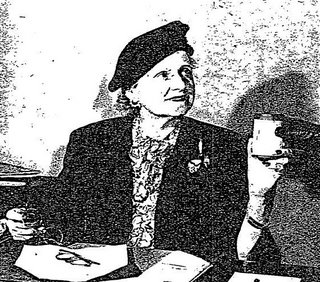Aida

Socialite and philanthropist Aida de Acosta Breckinridge, a real "get-it-done" woman, was born on this day in 1884 in Elberon, New Jersey.
The daughter of wealthy Cuban parents, Aida de Acosta attended the Sacred Heart Convent in Paris. While she was there, she became fascinated by the flying experiments of Alberto Santos-Dumont, who was in Paris testing his dirigible, the Santos-Dumont IX, by flying it around the Eiffel Tower. Attracted by the young woman's curiosity, Santos-Dumont began giving her ground instruction in the operation of his craft; and one Sunday afternoon (June 29, 1903), without a warning of his intentions, he impetuously hoisted the 19-year old de Acosta into the basket of the dirigible, started the engine and let loose the ropes, sending her on a 5-mile course and giving her instructions from his bicycle on the ground. By this impromptu flight, Aida became the first woman ever to pilot a dirigible. Her parents, reading about the incident in the newspapers, were so mortified by their daughter's un-ladylike display that they immediately dragged her back to New York.
Not to be kept under wraps, Miss de Acosta began to make a name for herself in charitable causes, starting a milk fund for poor children. She married Oren Root (nephew of diplomat Elihu Root) in 1908 and subsequently gave birth to 2 daughters, but during World War I she sold "Victory" bonds -- raising more than $2 million, a record-breaking sum, from stunts such as having Enrico Caruso sing to Wall Street from the steps of the Treasury Building in New York. After the War, she went to France with the American Committee for Devastated France, helping to provide food, shelter and day care to displaced families.
In 1922, while on vacation, she developed an eye inflammation, which turned out to be glaucoma; shortly thereafter, she and Root were divorced in Paris. After several operations, she managed to recover sight in one eye, and (following her marriage to her old friend, ex-assistant secretary of war Henry S. Breckinridge; they would divorce in 1947) she was inspired to raise over $5 million for what eventually became the Wilmer Opthalmological Institute at Johns Hopkins, opened in 1929. She followed this in 1944 by organizing the world's first bank for corneal transplants, the Eye Bank for Sight Restoration at the Manhattan Eye, Ear and Throat Hospital, an enterprise to which she devoted much of the rest of her life with indefatigable energy and an uncanny ability to keep people from saying "no."
De Acosta was also known as a patron of the arts, serving as New York City art commissioner (appointed by Fiorello LaGuardia in 1935) and financing such projects as Robert Flaherty's documentary, Twenty-Four Dollar Island (1925).
She died on May 26, 1962 in Bedford, New York.
Labels: Air and Space, Philanthropy, Trailblazing Women





0 Comments:
Post a Comment
Subscribe to Post Comments [Atom]
<< Home